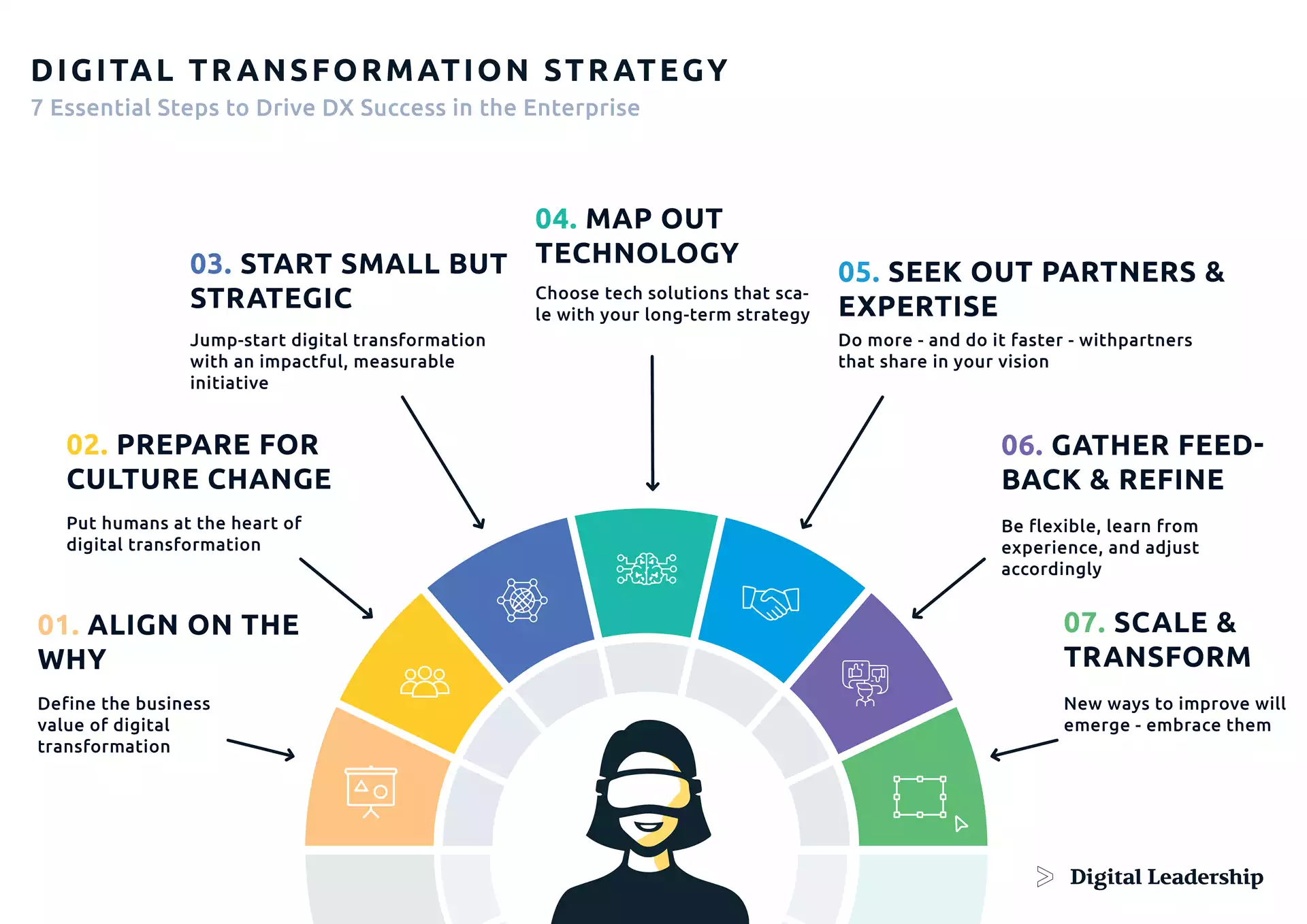Table of Contents
Corporate management 4.0: Why Digitization is Paramount to Boost Organizational Transformations
Society is changing at an unprecedented pace.
How can you ensure stable output at scale and still be innovative? Innovation vs. standardization is a balancing act, that most organizations fail to understand. With the UNITE Horizons of Growth framework, you know exactly when and how to improve, transform or innovate your business.
And this is where management and the organizational transformation model come into play. Digitization is one of the most important developments of the 21st century. It is a major transformation not only of the economy but society as a whole.
Successful organizational transformations heavily rely on effective corporate management, encompassing strategic decision-making, optimal resource allocation, impactful communication, and strong leadership. At Digital Leadership, our strategic management consulting and digital strategy consulting are designed to embody the core principles of collaboration, expertise, and customized solutions. We recognize that every organization has its own unique challenges and objectives. Our strategic management consulting services are centered around harnessing digital technologies and innovations to foster organizational growth and enhance competitiveness. By integrating digital strategy consulting into corporate management practices, organizations can unlock the potential of digital transformation, improve customer experiences, and achieve sustainable business outcomes.

Digitization poses the biggest challenge to the organizational transformation model
Digitization poses a challenge to many people, as we have our old habits and customs and can still function without technology. Driving digitization is therefore currently one of the most demanding tasks and requires not only technical knowledge but mainly people skills.
The UNITE model gives clear advice on how to actively implement a paradigm shift In dealing with the organization, leadership, and team members. UNITE stands for “understanding and navigating innovation and transformation in enterprises” and offers you a framework of how to boost structural change in the organization through digitization:
- U = Understanding and
- N = Navigating
- I = Innovation and
- T = Transformation in
- E = Enterprises
Digitization is regarded as the supreme discipline when it comes to leading our transformation objective. It is much faster, much more comprehensive, and much more networked than any other tasks we are facing.
How corporate digitization is shaping companies
As one of the biggest trends, digitization will shape the 21st century: It opens up access to extensive knowledge and allows information and communication to be transmitted around the globe within seconds. Processes can be designed more efficiently, which may even make human intervention superfluous.
At the same time, it enables completely new business models. Companies need to compete in an open environment, in which customers can choose competitors from all over the world and have all the necessary information at their fingertips. They are more informed and are no longer impressed by well-trained salespersons. They are fully aware of the value proposition and want to be convinced with real customer benefits. The competitive advantage that once existed for years can no longer be relied on.
This requires streamlined processes in order to keep the costs as low as possible and an innovative mindset to come up with solutions, which best serve the customer base. Companies, therefore, have to overcome significantly higher hurdles if they want to stand out of the crowd. Companies need to stop focusing on technical solutions only, and instead, keep people at the core. A good organization transformation example would include an ERP system, which is actually used by the team members, as it makes their work easier.
How to Create Innovation is a practical and comprehensive workbook for students, innovators, designers, government, and corporate leaders who appreciate and are curious about the pace of innovation and emerging technologies. It challenges the status quo of our mindsets and beliefs and provides the strategic approaches required for the next part of the journey. Leverage the UNITE Innovation & Transformation framework to build your own story and create a world worth living in!
How does digitization affect organizational transformations?

The effects of digitization are not limited to the optimization of individual processes, but penetrate all areas of your business. In the following section, we are taking a closer look at the most important drivers: organization, corporate culture, structures and communication.
Organization
The focus of digitization remains on the organization: The organizational transformation model coordinates all functions, processes, and people within the organization in order to change the status quo to achieve the desired outcome. It goes without saying that management plays a pivotal role in the success of the digital transformation.
Corporate Culture
Like all other innovations or changes, some employees are enthusiastic about digitization, while others reject it. An open culture helps steer the transformation process in a direction, where most people inside the organization can agree on.
Structures
Digitization means empowering people. Therefore, the transformation process consists of much more than just introducing new technologies. Processes need to give your staff more freedom to make individual decisions. This means that hierarchical structures are becoming even more outdated.
Communication
Digital communication channels are already replacing traditional channels. The decisive factor is how customers and stakeholders can be reached reliably. Managers and employees need to follow the trends closely.
People are the focal point of the organizational transformation model
Digitization is people-driven. It already starts with management leading our transformation objective. Digital transformation needs to be adopted by all stakeholders involved in the processes of an organization. Therefore, a paradigm shift is needed, which includes the company, management, and processes.
This is where we need to introduce the term “agile organization”. An agile organization is able to adapt to and drive change. It requires agile leaders, who rely on flat hierarchies, coaching, and empowerment of all team members.
A dominant hierarchy that relies on shared functions and rigid planning will not be able to keep up. Organizational silos even prevent innovative forces from developing. The entire value chain requires a critical analysis in order to collect and process all information.
Ultimately, digital transformation should be used for the benefit of all stakeholders. Companies have the responsibility of leading our transformation objective and giving employees more personal responsibility.
At the same time, however, certain rules and boundaries are also required to contain the flood of information and to maintain data security. New communication channels need to be mastered, as they control all areas of our society today.
Therefore, a best practice organization transformation example is to put people at the heart of digital transformation. It requires agile leadership, flat hierarchies and the willingness to change throughout the entire organization. Team member buy-in is crucial to success.
Create Innovation by using the strategic approach that you need for the next part of your Journey, Sign Up for our Upcoming Book Today! www.digitalleadership.com/createinnovation
Summary: Digital transformation requires agile leadership and people focus
The challenges of today’s day and age are enormous: A manageable group of people is no longer enough to achieve promising changes in companies. Digital transformation poses unexpected challenges for today’s organizations and, above all, managers.
The bottom line is that it is important to effectively process enormous amounts of knowledge and information as quickly as possible. It’s about viable decisions that can be made responsibly and implemented quickly. Digital transformation is not limited to the implementation of a few software applications: It turns today’s corporate world upside down in all areas.
Decision-makers need to shift their focus and acquire an agile mindset. Tackling individual products, processes, and organizational areas is not enough anymore: Rather, it is about the fundamental change in the business models that the economy has to deal with if it wants to meet the increased demands on individualization, sustainability, speed, and networking.
To get started and benefit from all the opportunities that digitization offers, we advise you to take a closer look at the UNITE model. The UNITE model provides you with a great framework of how to bring your business to the next level and prepare for the challenges of the 21st century.
Get access to the 50+ UNITE Innovation & Transformation Models which are fully OpenSource and entirely free to download!


































 Book How to Create Innovation
Book How to Create Innovation